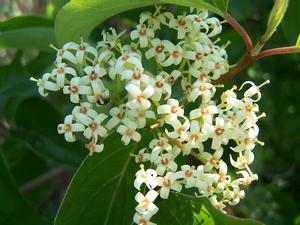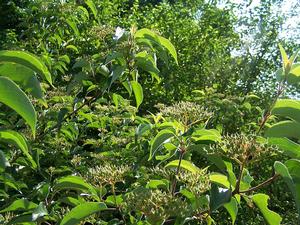Two Shrub Dogwoods for Your Appraisal
Two shrub dogwoods, Cornus amomum and C. racemosa make for good wildlife plants with excellent ornamental qualities, too. The first is the Gray Dogwood. The second is the Silky Dogwood.
A fine shrub dogwood native to northeastern Connecticut is the Cornus racemosa, the Gray Dogwood. Multitudes of white, flattened coins in the template of cymes grow 2 inches in diameter. They draw all manner of winged pollinators but especially bees. Flowers are easily pollinated by all who seek nectar. The spent florets then develop bright green swellings which expand as the summer wears. Glossy green fruits by late summer have achieved full girth. These give way to mature white fruits studded with a black eye at the apex where the petals once conjoined. They are showy set atop green-turned-juicy-red branched pedicels in autumn. Fall foliage color is generally bronze to red-maroon occurring with the berry and pedicel show. Winter interest is moderately good: second and third-year wood is an earthy chalk red; first year twigs are deep ruby with glossy effervescence. Older wood is, well... ashy gray, of course. Nice!
C. racemosa is a colonizing species. It may be one to three years before you may notice young shoots rising from the ground adjacent to your original shrub. The wise gardener will consider this fact in finding an appropriate landscape situation. Fertile, draining ground and plenty of sun will set the table for wildlife as you savor its ornamental qualities.
Gray Dogwood which can grow from six to twelve feet tall is useful as a wildlife plant, in a larger, mixed wildlife hedgerow or it may be allowed to colonize at the base of a stand of tall trees or as an island in the middle of a great lawn in park or estate where it will form a very attractive thicket. Its origins cross a broad swath of eastern North America from PEI west to Manitoba (excluding Labrador), south to Nebraska and Texas skipping Kansas and Oklahoma. Gray Dogwood occurs in all states to the Atlantic seaboard from the central U.S. axis except the deep south. USDA hardiness if from zones 3b (-35F) through 8.
There are several fine selections. Huron™ is a more compact cultivar only growing 4 to 5 feet tall and wide. Fall foliage turns a handsome red. Its shorter stature would make this an excellent choice in lining a broad, curved path made with stone or pavers. Huron would also be handsomely used as a step down set before taller background shrubs.
Musingum™ is dwarfer than Huron as this shorty only grows 24 to maybe 30 inches tall with fecund spring bloom and attractive fall colors. It's shorter height will allow for tiered effect in a mixed shrub border, edging in a larger landscape - its deciduous circadian rhythm in changing contrast set before a conifer hedge or hedgerow.
'J.N. Red Stem' is actually a hybrid shrub dogwood with C. racemosa as one of its parents, C. amomum, the discussion of which will follow, is the other. Also known as Irish Setter™, think red. This well-named excellent ornamental offers beautiful red to red-purple autumn leaves while the wood turns an earthy red that holds all through the winter. New wood sprouts red-hued. Irish Setter is taller growing achieving 10 to 12 feet with equal spread. Paired with other woodies, evergreen and deciduous 'Irish Setter' could be a beautiful contrasting component in a hedgerow or screen. It could be an effective specimen in the larger landscape. For the control freaks among us it could conceivably be trained into a small tree with mower and the pruners at the ready.
Gray Dogwood will not only feed the birds with the plethora of white fruits but this under-appreciated shrub will provide safe sanctuary when allowed to colonize for a number of bird species who nest closer to the ground. We've had song sparrows and catbirds in ours. More sun will likely encourage shorter, denser and more floriferous shrubs that will develop even deeper autumn leaf color with greater fruiting. Plant in fertile, draining ground. Gray Dogwood isn't a dog so to speak; it affords fine autumn interest, is attractive in all other seasons and is a bonanza of natural wealth for wildlife. It is certainly underutilized and worthy of consideration.
Cornus amomum, Silky Dogwood graces us with 1.5 to 2.5-inch creamy flat-topped cymes studding medium green foliage set up like silver dollar coins in May into June. The plethora of yellow pollen upon multitudinous anthers blanketing the white petals provide the cream tint. Florets are fertilizeded by the host of pollinators that will appreciate this fine shrub's presence. These will develop resplendent gorgeous porcelain blue clusters of berries with a glossy sheen in late season clusters. Where fruits differ is that Silky Dogwood tends to cluster less formally - in looser, more casual groupings than does Cornus racemosa. Berries tend to be larger. And that porcelain blue is exceptional. Often the berries contrast with mahogany to bronze-purple autumn foliage color which when occurring together is sumptuous. Winter stem color is ruddy reddish-purple and olive green - not knockout winter interest but not bad either especially when set with shrubs or trees whose winter facade will accentuate the colors. Against a backdrop of snow the color really stands out. Branches are often lyrical in a somewhat sinuous exhibition and less stiff in look as compared to those of other shrub dogwoods.
One noteable selection is Cayenne™. We are smitten with this selection as we are the aforementioned hybrid, 'Irish Setter'. Cayenne's leaves metamophose from summer green to autumn ruddy red-bronze. The fall colors with its golssy blue berries is deliciously rich and satisfying to human aesthetic.
Silky Dogwood may grow from six to eight feet tall, over time broadening even wider to as much as ten feet. Hardy from USDA zone 3 to 6 Silky Dogwood is found in all of the eastern U.S. plus juts into the heart of the country in Iowa and Missouri. Site Silky Dogwood in a spectrum from full sun to mostly open shade exposure planted in fertile moisture-retentive soil. This, as with all Dogwoods whose slicing and dicing reclassification by taxonomists does not alter the fact that this is another fine wildlife plant for many species, is at home in a hedgerow, is smartly-used as element in a naturalistic screen or interred as a colony to feed wildlife and simultaneously creating nesting opportunities for birds.
As with all shrub Dogwood whose winter stems provide color interest it is the youngest stems that offer the most saturated tones. Pruning down older wood will engender new brightly-colored new stems. Pruing down to 6 inches will suffice.
For native enthusiasts, for the pollinators in spring, for the birds who appreciate late season bounty and possible nesting opportunities you may want to consider these two easy-to-please shrub dogwoods. Dig in. Have fun.
Wayne Paquette
February 11, 2022

Cornus racemosa closeup of a raceme
